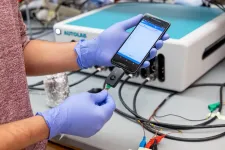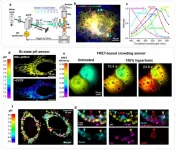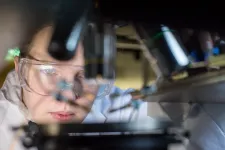(Press-News.org) PHILADELPHIA--A low-cost, rapid diagnostic test for COVID-19 developed by Penn Medicine provides COVID-19 results within four minutes with 90 percent accuracy. A paper published this week in Matter details the fast and inexpensive diagnostic test, called RAPID 1.0 (Real-time Accurate Portable Impedimetric Detection prototype 1.0). Compared to existing methods for COVID-19 detection, RAPID is inexpensive and highly scalable, allowing the production of millions of units per week.
Despite the urgency of the pandemic, most available methods for COVID-19 testing use RT-PCR--reverse transcription polymerase chain reaction--to detect SARS-CoV-2. Though effective, the technique requires large laboratory space and trained workers to employ. These tests are also costly, they run a risk of cross-contamination, and can take hours or days to provide results.
RAPID was developed by a team led by César de la Fuente, PhD, a Presidential Assistant Professor in Psychiatry, Microbiology, Chemical and Biomolecular Engineering, and Bioengineering, to quickly and accurately detect the virus while remaining cheap enough to be widely accessible. An electrode printed using a screen printer--thousands of which can be printed in a day at very low cost--can detect the virus in nasal swab or saliva samples. The results can be read on a benchtop instrument or on a smartphone.
"Prior to the pandemic, our lab was working on diagnostics for bacterial infections. But then, COVID-19 hit. We felt a responsibility to use our expertise to help--and the diagnostic space was ripe for improvements," de la Fuente said. "We feel strongly about the health inequities witnessed during the pandemic, with testing access and the vaccine rollout, for example. We believe inexpensive diagnostic tests like RAPID could help bridge some of those gaps."
The RAPID technology uses electrochemical impedance spectroscopy (EIS), which transforms the binding event between the SARS-CoV-2 viral spike protein and its receptor in the human body, the protein ACE2 (which provides the entry point for the coronavirus to hook into and infect human cells), into an electrical signal that clinicians and technicians can detect. That signal allows the test to discriminate between infected and healthy human samples. The signal can be read through a desktop instrument or a smartphone.
The team assessed the performance of RAPID using both COVID-19 positive and negative clinical samples from the Hospital of the University of Pennsylvania, including samples of the highly contagious UK B117 variant. In blinded tests, they analyzed 139 nasal swab samples--109 of which were COVID-19 positive and 30 COVID-19 negative, as determined by standard RT-PCR clinical assessments. The team also analyzed 50 saliva samples from patients. For the nasal swab samples, RAPID was 87.1 percent accurate. For saliva samples, RAPID was 90 percent accurate.
RAPID provides results in four minutes, which is faster than most methods currently available for diagnosing COVID-19. For example, serological tests can take around 15 to 20 minutes, and they are about 60 to 70 percent accurate. In addition, RAPID is able to detect COVID-19 at extremely low concentrations (1.16 PFU mL), which corresponds to a viral load that correlates with the initial stages of COVID-19 (about two to three days after onset of symptoms). This is beneficial for detecting individuals at the earliest stages of infection, allowing for rapid care and the potential decrease of further viral spread.
"Quick and reliable tests like RAPID allow for high-frequency testing, which can help identify asymptomatic individuals who, once they learn they are infected, will stay home and decrease spread. We envision this type of test being able to be used at high-populated locations such as schools, airports, stadiums, companies--or even in one's own home," said first author Marcelo Der Torossian Torres, PhD, a postdoctoral researcher at Penn.
Importantly, the technology is affordable and scalable. Each test, which can be performed at room temperature, costs $4.67 to produce. Additionally, the electrodes used in the test can be quickly mass-produced using commercially available screen-printers to print the circuit board (named eChip). One laboratory-sized unit is able to produce 35,000 electrodes daily (about 1.05 million per month).
The team also constructed an electrode for RAPID composed of filter paper, which is a more accessible and inexpensive material. Named ePAD, the researchers demonstrated the applicability of ePAD for RAPID in a portable method, connected to a smart device, which may enable further scale and on-demand testing capabilities at the point-of-care.
"Having low-cost tests which are quick and easy to read extends testing to not only people who can afford it, but to remote or disadvantaged areas," de la Fuente said.
De la Fuente lab's research focuses primarily on developing technologies that help understand, prevent, and treat infectious diseases. Though RAPID was developed as a COVID-19 test, the technology can be used to detect other viruses and diagnose a variety of diseases such as the flu or sexually transmitted diseases.
INFORMATION:
The research was supported by the Nemirovsky Prize, the Dean's Innovation Fund from the Perelman School of Medicine at the University of Pennsylvania, Brazil's Coordination for the Improvement of Higher Education Personnel (88887.479793/2020-00), São Paulo Research Foundation (2018/08782-1), FAEPEX/PRP/UNICAMP (3374/19), and Brazil's National Council for Scientific and Technological Development (438828/2018-6, 401256/2020-0). A provisional patent application has been filed on the technology described in this manuscript (Invention Disclosure 21-9515).
Penn Medicine is one of the world's leading academic medical centers, dedicated to the related missions of medical education, biomedical research, and excellence in patient care. Penn Medicine consists of the Raymond and Ruth Perelman School of Medicine at the University of Pennsylvania (founded in 1765 as the nation's first medical school) and the University of Pennsylvania Health System, which together form a $8.9 billion enterprise.
The Perelman School of Medicine has been ranked among the top medical schools in the United States for more than 20 years, according to U.S. News & World Report's survey of research-oriented medical schools. The School is consistently among the nation's top recipients of funding from the National Institutes of Health, with $496 million awarded in the 2020 fiscal year.
The University of Pennsylvania Health System's patient care facilities include: the Hospital of the University of Pennsylvania and Penn Presbyterian Medical Center--which are recognized as one of the nation's top "Honor Roll" hospitals by U.S. News & World Report--Chester County Hospital; Lancaster General Health; Penn Medicine Princeton Health; and Pennsylvania Hospital, the nation's first hospital, founded in 1751. Additional facilities and enterprises include Good Shepherd Penn Partners, Penn Medicine at Home, Lancaster Behavioral Health Hospital, and Princeton House Behavioral Health, among others.
Penn Medicine is powered by a talented and dedicated workforce of more than 44,000 people. The organization also has alliances with top community health systems across both Southeastern Pennsylvania and Southern New Jersey, creating more options for patients no matter where they live.
Penn Medicine is committed to improving lives and health through a variety of community-based programs and activities. In fiscal year 2020, Penn Medicine provided more than $563 million to benefit our community.
Central to any technological progress is the enrichment of human life. The internet and wireless connectivity have done that by allowing not only virtually anyone anywhere to connect real time, but by making possible connections between humans and a range of intelligent devices both indoors and outdoors, putting smart cities on the horizon.
One key aspect of realizing smart cities is "smart vehicles", the latest development in intelligent transportation systems (ITS), which involve the integration of communication, mapping, positioning, network, and sensor technologies to ensure cooperative, efficient, intelligent, safe, and economical transportation.
For decades, research on bringing to the streets smart vehicles that operate ...
The field of magnonics offers a new type of low-power information processing, in which magnons, the quanta of spin waves, carry and process data instead of electrons. The end goal of this field is to create magnonic circuits, which would be smaller and more energy-efficient than current electronic ones.
Until recently, the development of a functional magnonic device could take years of trial-and-error. Researchers from the University of Vienna and the TU Kaiserslautern have developed a new computational method to design new devices in a considerably shorter time. Moreover, the efficiency added through this novel inverse design method helps overcome a traditional problem with such devices: they were just suitable for one function only. Now, thanks to the proposed ...
The inhibition of pathological protein-protein interactions is a promising approach for treating a large number of diseases, including many forms of cancer. A team of researchers has now developed a bicyclic peptide that binds to beta-catenin--a protein associated with certain types of tumor. The secret of their success is the cyclic nature and the hairpin shape of the peptide, which mimics a natural protein structure, they report in the journal Angewandte Chemie.
Because of the extensive protein regions involved in protein-protein interactions, therapeutic approaches involving small molecules are often unsuccessful. Protein mimetics are alternatives that imitate the spatial structure of binding segments of natural protein binding partners. ...
In a new study from Lund University and the University of Gothenburg, patients were interviewed about their experiences ten years after undergoing obesity surgery. The results show that the effect on eating and weight regulation persisted, whereas other problems, such as feelings of guilt about still not being healthy enough, remained.
"This is one of few follow-ups from a patients perspective so long after surgery", says My Engström, researcher in nursing at the University of Gothenburg.
18 patients were interviewed in the study. All of them experienced that their eating habits and appetite were still affected after the operation: their bodies still objected, preventing ...
Mycobacterium tuberculosis is incredible in that it can survive for decades within its human host. It does this by varying its diet to successfully steal nutrients from the human host including immune cells; it is known to acquire and absorb multiple carbon sources from the body during infection.
In a paper published in the journal Molecular Systems Biology, Surrey scientists detail how they measure the flow of metabolites or "fluxes" through metabolic pathways when Mycobacterium tuberculosis is consuming some of its favourite nutrients. Measuring these 'fluxes' could help scientists advance new tuberculosis drugs as well as understand why the bacterium survives so long in humans and why current antibiotics are often ineffective.
By growing Mycobacterium ...
The multiplexing capability of fluorescence microscopy is severely limited by the broad fluorescence spectral width. Spectral imaging offers potential solutions, yet typical approaches to disperse the local emission spectra notably impede the attainable throughput and place substantial constraints on temporal resolution. Tunable bandpass filters provide a possibility to scan through the emission wavelength in the wide field. However, applying narrow bandpasses to the fluorescence emission results in inefficient use of the scarce signal.
In a new paper published in Light: Science & Application, a team of scientists, led by Professor Ke Xu ...
The DNA sequences produced are also called oligonucleotides. These are widely used for disease identification, for the manufacture of oligonucleotide-based drugs, and for several other medical and biotechnological applications.
The high demand for oligonucleotides therefore requires an efficient automated method for their chemical production.This process relies on phosphoramidites, which are chemical compounds that have the disadvantage of being unstable unless stored at the ideal -20 degrees Celsius.
Instruments used for DNA synthesis are not able to cool down the phosphoramidites, and consequently it is unavoidable that some of them degrade after being added ...
"We're meant to be crossing over ... but the bridge is broken": 2020 university graduates' experiences of the pandemic in Ireland
A new study from Trinity College Dublin investigating the impact of the COVID pandemic on young adults finds that they are vastly more affected than older people, and the reverberations of the disruption to some will last decades. Researchers say this group have paid a high price in the form of foregone opportunities for education, social networks, and labour market integration.
The research, involving university graduates in Ireland, is published in YOUNG: ...
A researcher at University of Limerick has developed a low-cost, environmentally friendly sensor that can detect damage in pipelines and could save water as a result.
The damage detection sensor uses highly sensitive, eco-friendly crystals that generate an electrical signal in response to a leak.
It is the first validation of these biological crystals for real world applications, according to Dr Sarah Guerin, a postdoctoral researcher at the Department of Physics and the Bernal Institute in UL, who has been developing amino acid crystal devices since 2017.
An Irish research collaboration between the Bernal Institute at UL and the Dynamical Systems and Risk Laboratory in University College Dublin has validated ...
In mathematics, simple equations can generate a complex evolution in time and intriguing patterns in space. One famous example of this is the Mandelbrot set, named after the French-American mathematician of Polish origin, Benoit B. Mandelbrot (1924-2010), the most studied fractal. This set is based on a single quadratic equation with only one parameter and one variable. The fascinating fractal patterns of the Mandelbrot set have attracted attention far beyond mathematics.
An article by Ralph Andrzejak, entitled "Chimeras confined by fractal boundaries in the complex plane", forms part of a special edition of the journal Chaos in memory of Russian professor Vadim S. Anishchenko, (1943-2020), published on 3 May 2021. Andrzejak is head of the Nonlinear Time Series Analysis Group ...





